CDL Practice Tests: Flatbed Cargo Securement
Choose A Section:
Go!If loading and securing paper rolls on a second layer:
- Stack the second layer at the back.
- Lay the second layer horizontally.
- Be sure the bottom layer extends to the front of the vehicle.
- Make sure heavier rolls are on top.
Stacked Loads
- Load paper rolls on a second layer only if the bottom layer extends to the front of the vehicle.
-
Prevent forward, rearward, or side-to-side movement:
- Either by the same means required for the bottom layer
- Or by the use of a blocking roll from a lower layer.
- A roll in the rearmost row of any layer must not be raised using dunnage.
One option of positioning bundles of building materials is:
- Lean them against each other.
- Place them in direct contact with each other.
- Turn them so only their corners are touching.
- Lean them to the outside.
Choose one of two options for positioning bundles:
-
Option #1:
Place bundles in direct contact with each other.
-
Option #2:
Provide a means (such as dunnage or blocking) to prevent the bundles from shifting towards each other.
When securing a load of lengthwise longwood logs weighing 42,500 lbs, what is the minimum aggregate WLL required for tiedowns? (rounded up to nearest lb)
- 10,000 lbs
- 8,550 lbs
- 21,250 lbs
- 7,085 lbs.
Working load limit for longwood and shortwood loaded lengthwise
The aggregate working load limit for all tiedowns must be no less than 1/6 the weight of the stack of logs.
Note: This requirement is much less than the general requirement of an aggregate working load limit equal to 1/2 the weight of the load. This lowered requirement recognizes that the bunks/stakes help to prevent slippage.
When loading bell pipe on one tier, all of the following apply except:
- If the ends cannot be staggered, they must be aligned.
- Load bell pipe on one tier so that the bells all lie on one side of the vehicle.
- Load bell pipe on one tier so that the bells alternate on opposite sides of the vehicle.
- If possible, the ends of consecutive pipe must be staggered within the allowable width.
One tier
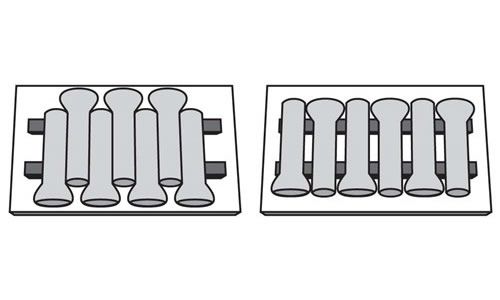
Load bell pipe on one tier so that the bells alternate on opposite sides of the vehicle.
If possible, the ends of consecutive pipe must be staggered within the allowable width.
If the ends cannot be staggered, they must be aligned.
When loaded cement pipe over 45 inches in diameter, which pipes should be blocked, wedged, or otherwise immobilized?
- It depends on the weight of the load.
- Front and rear.
- Rear only.
- Front only.
Immobilize the front and rear pipe with on of the following methods:
- Blocking
- Wedges
- Vehicle end structure
- Stakes
- Locked pipe unloader
- Other equivalent means
The Aggregate Working Load Limit should, at minimum, be:
- Determined by the shipper.
- 50% of the weight of the cargo.
- 100% of the weight of the cargo.
- 80% of the weight of the cargo.
How much should the Aggregate Working Load Limit be?
The aggregate working load limit of any securement system must be at least 50% of the weight of the cargo being secured.
When securing concrete pipe with a diameter of more than 45 inches loaded crosswise, how many tiedowns are required through each pipe at minimum?
- 3
- 2
- 1
- It depends on the weight of the pipe.
Requirements for securing the pipe
Secure each pipe with tiedowns through the pipe.
Run at least one tiedown through each pipe in the front half of the load. This includes the middle one if there are an odd number. The tiedown must run rearward at an angle not more than 45░ with the horizontal when viewed from the side of the vehicle, whenever practicable.
Run at least one tiedown through each pipe in the rear half of the load. The tiedown must run forward at an angle not more than 45░ with the horizontal when viewed from the side of the vehicle, whenever practicable. This holds each pipe firmly in contact with adjacent pipe.
The maximum distance from the rear allowed for attaching mechanisms used to secure roll-on/roll-off containers is:
- 6 1/2 feet
- 3 feet
- It doesn't matter.
- 2 feet
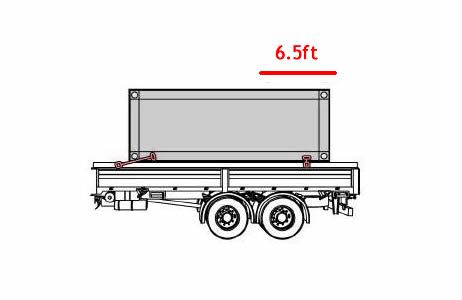
Attach mechanisms used to secure the rear end of a roll-on/roll-off or hook lift container no more than two meters (6.5 feet) from the rear of the container.
Specific cargo securement rules on automobiles and light trucks apply to vehicles of what weight?
- 4,500 lbs or less
- It depends on what the vehicle is used for.
- 10,000 lbs or less
- 12,000 lbs or less
What Does This Section Cover?
The requirements in this section apply to the transportation of automobiles, light trucks, and vans that individually weigh 4500 kg (10,000 lb.) or less.
All of the following are requirements for transporting coils with eyes crosswise except:
- Prevent the coil from rolling
- Attach one tiedown rearward
- Attach one tiedown forward
- These are all requirements
There are three requirements for coils transported with eyes crosswise:
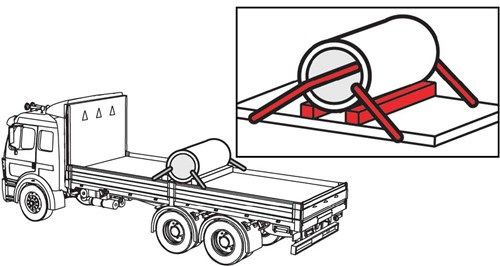
Prevent the coil from rolling
Attach one tiedown forward.
Attach one tiedown rearward.
About The Flatbed Cargo Securement CDL Manual
Studying the flatbed cargo securement CDL manual is not a requirement for getting your CDL permit or license. It is required knowledge for flatbed drivers.
Some questions you should be able to answer for flatbed cargo securement:
- What is the minimum Working Load Limit of a tiedown used to secure logs?
- What is the minimum weight of a shipment of paper rolls that would require specific securement requirements?
- When securing concrete pipe over 45 inches loaded crosswise, which direction must the tiedowns on the front half of the load run?
- What is a cab shield?
- When securing concrete pipe over 45 inches loaded crosswise, which direction must the tiedowns on the rear half of the load run?
- What is a dunnage bag?
- Who is responsible for inspecting securing devices and cargo within the first 50 miles?
- How many tiedowns are required on a stack of shortwood loaded crosswise?
- What is the minimum working load limit of each tiedown used to secure crushed or flattened vehicles?
- Define 'bolster'
- What is a hook-lift container?
- When a tiedown is attached directly to the cargo, what is the ideal angle where it attached to the vehicle?
What is a securing device?
Any device specifically manufactured to attach or secure cargo to a vehicle or trailer:
- Synthetic Webbing
- Chain
- Wire rope
- Manila rope
- Synthetic rope
- Steel strapping
- Clamps and latches
- Blocking
- Front-end structure
- Grab hooks
- Binders
- Shackles
- Winches
- Stake pockets
- D-rings
- Webbing ratchet
- Bracing
- Friction mat
What is a tiedown?
A combination of securing devices that forms an assembly that:
- Attaches cargo to, or restrains cargo on a vehicle.
- Is attached to anchor point(s).
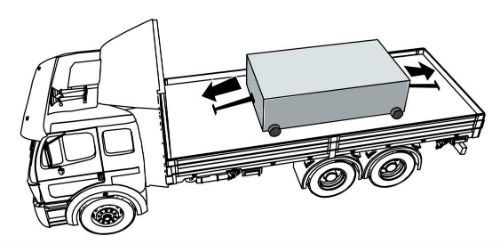
Some tiedowns are attached to the cargo and provide direct resistance to restrain the cargo from movement.
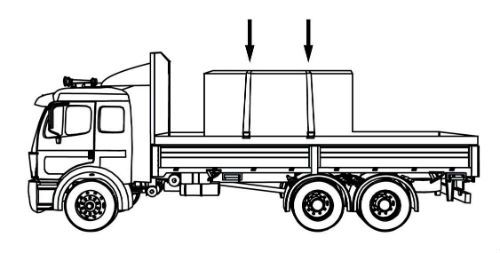
Some tie-downs pass over or through the cargo. They create a downward force that increases the effect of friction between the cargo and the deck. This friction restrains the cargo.
 Related Cargo Securement Terms That Every Driver Should Know:
Related Cargo Securement Terms That Every Driver Should Know:
-
Tiedown:
A combination of securing devices which form an assembly that attaches cargo to, or restrains cargo on, a vehicle or trailer, and is attached to anchor point(s).
-
Contained:
Cargo is contained if it fills a sided vehicle, and every article is in contact with or sufficiently close to a wall or other articles so that it cannot shift or tip if those other articles are also unable to shift or tip.
-
Blocking:
A structure, device, or another substantial article placed against or around an article to prevent horizontal movement of the article.
How should tiedowns be attached?
Tiedowns can be used in two ways:
-
Attached to the cargo:
- Tiedowns attached to the vehicle and attached to the cargo.
- Tiedowns attached to the vehicle, pass through or aroundan article of cargo, and then are attached to the vehicle again.
-
Pass over the cargo:
- Tiedowns attached to the vehicle, passed over the cargo, and then attached to the vehicle again.
Tiedown placement:

Place the tiedown as close as possible to the spacer.
Position the tiedowns as symetrically as possible over the length of the article.

Position the tiedowns to preserve the integrity of the article.







 TT On Facebook
TT On Facebook